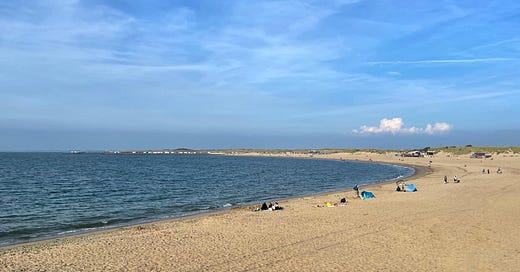This evening, I captured this photograph on the northern shore of the island. In the foreground lies the vast expanse of Schouwen's sandy beach, stretching out before you. Yet, as your gaze follows the bend to the left, and you look carefully, you'll notice that the beach on the other side of that curve is not a native part of our island. It results from the love-hate relationship in this province of Zeeland between land and sea, where the sand has accumulated against the dam that connects us to the next island to the north.
These beaches and dunes are not the mere consequence of human engineering; instead, the stones and concrete used have become a canvas for nature. The plants have taken root here as if this were their eternal home. They've woven themselves into the very fabric of the dam, harmoniously integrating it into the island's natural landscape.
This spot on the north shore illustrates the resilience of nature, the way it adapts, transforms, and makes even the most artificial structures a part of its timeless beauty. In the year that I was born, the construction of the dam was finished. Many feared the island would lose its character since it was no longer an actual island. But the dam integrated into nature, and its beaches and dunes are now visited by nature lovers.
Here, on the boundary where my island meets the might of the North Sea, a delicate equilibrium is maintained. The dam, designed to protect us from the relentless forces of the ocean, now stands as a monument to nature's ability to reclaim, renew, and redefine.
Nature's resilience is a story that I keep telling in many varieties; there is the version full of admiration, hope, and positivity, but there is also the one where I show that other reality, the one where our ignorance and arrogance irreparably destroy nature.
This evening, I could have written that other version where I could have focussed on the wildfires in Canada that have burned an area the size of Wisconsin this summer. Or I could have chosen to write about the recent extreme heatwaves worldwide, the record low levels of Antarctic sea ice, or the nearly five million hectares of forest lost yearly. The list is long and growing.
But as I stood there, overlooking the beach, capturing this image, with the sea breeze in my hair, I marveled at the interplay between the man-made and the organic. It's a scene that speaks to the powerful and intricate relationship between humanity and our natural world.
Standing at that spot on the beach, I felt strongly that this connection deserves our respect and stewardship. So, what I share with you tonight is not just a photograph; it's a short story of resilience, adaptation, and the enduring beauty of the places we call home.
And this island is my home.







Beautifully written. Thanks for sharing.
Yes, this island is your home. That is a wonderful feeling. And the stewardship you speak of involves all inhabitants. You have community to combat the dark forces of climate instability. That is the piece I yearn for in the USA. We are at present 50 units, not a community for all. I wonder at the beginning of this grand experiment why it was necessary to evolve into 50 states. But I am not well read on other nations structures so could be the “cantons” Evelyne speaks of in Switzerland are similar. How do the Netherlands divvy up areas for governance? I could google; just thought I’d ask. Also interested in your sovereign and responsibilities of same as compared to the UK for example. A background in geography encompasses much of these details I would imagine. Thinking more research (basic) needed!